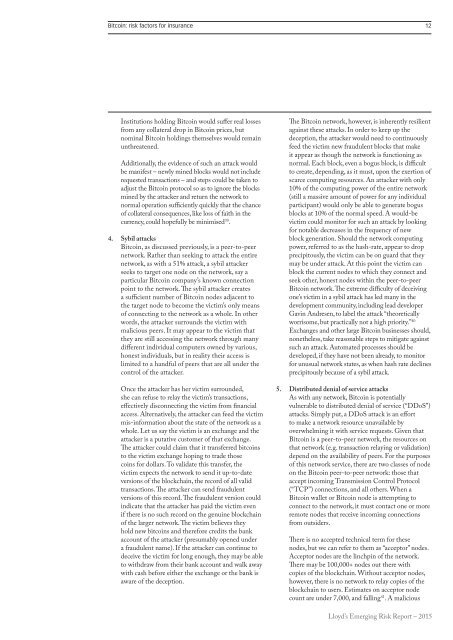bitcoin final
bitcoin final
bitcoin final
Create successful ePaper yourself
Turn your PDF publications into a flip-book with our unique Google optimized e-Paper software.
Bitcoin: risk factors for insurance 12Institutions holding Bitcoin would suffer real lossesfrom any collateral drop in Bitcoin prices, butnominal Bitcoin holdings themselves would remainunthreatened.Additionally, the evidence of such an attack wouldbe manifest – newly mined blocks would not includerequested transactions – and steps could be taken toadjust the Bitcoin protocol so as to ignore the blocksmined by the attacker and return the network tonormal operation sufficiently quickly that the chanceof collateral consequences, like loss of faith in thecurrency, could hopefully be minimised 39 .4. Sybil attacksBitcoin, as discussed previously, is a peer-to-peernetwork. Rather than seeking to attack the entirenetwork, as with a 51% attack, a sybil attackerseeks to target one node on the network, say aparticular Bitcoin company’s known connectionpoint to the network. The sybil attacker createsa sufficient number of Bitcoin nodes adjacent tothe target node to become the victim’s only meansof connecting to the network as a whole. In otherwords, the attacker surrounds the victim withmalicious peers. It may appear to the victim thatthey are still accessing the network through manydifferent individual computers owned by various,honest individuals, but in reality their access islimited to a handful of peers that are all under thecontrol of the attacker.Once the attacker has her victim surrounded,she can refuse to relay the victim’s transactions,effectively disconnecting the victim from financialaccess. Alternatively, the attacker can feed the victimmis-information about the state of the network as awhole. Let us say the victim is an exchange and theattacker is a putative customer of that exchange.The attacker could claim that it transferred <strong>bitcoin</strong>sto the victim exchange hoping to trade thosecoins for dollars. To validate this transfer, thevictim expects the network to send it up-to-dateversions of the blockchain, the record of all validtransactions. The attacker can send fraudulentversions of this record. The fraudulent version couldindicate that the attacker has paid the victim evenif there is no such record on the genuine blockchainof the larger network. The victim believes theyhold new <strong>bitcoin</strong>s and therefore credits the bankaccount of the attacker (presumably opened undera fraudulent name). If the attacker can continue todeceive the victim for long enough, they may be ableto withdraw from their bank account and walk awaywith cash before either the exchange or the bank isaware of the deception.The Bitcoin network, however, is inherently resilientagainst these attacks. In order to keep up thedeception, the attacker would need to continuouslyfeed the victim new fraudulent blocks that makeit appear as though the network is functioning asnormal. Each block, even a bogus block, is difficultto create, depending, as it must, upon the exertion ofscarce computing resources. An attacker with only10% of the computing power of the entire network(still a massive amount of power for any individualparticipant) would only be able to generate bogusblocks at 10% of the normal speed. A would-bevictim could monitor for such an attack by lookingfor notable decreases in the frequency of newblock generation. Should the network computingpower, referred to as the hash-rate, appear to dropprecipitously, the victim can be on guard that theymay be under attack. At this point the victim canblock the current nodes to which they connect andseek other, honest nodes within the peer-to-peerBitcoin network. The extreme difficulty of deceivingone’s victim in a sybil attack has led many in thedevelopment community, including lead developerGavin Andresen, to label the attack “theoreticallyworrisome, but practically not a high priority.” 40Exchanges and other large Bitcoin businesses should,nonetheless, take reasonable steps to mitigate againstsuch an attack. Automated processes should bedeveloped, if they have not been already, to monitorfor unusual network states, as when hash rate declinesprecipitously because of a sybil attack.5. Distributed denial of service attacksAs with any network, Bitcoin is potentiallyvulnerable to distributed denial of service (“DDoS”)attacks. Simply put, a DDoS attack is an effortto make a network resource unavailable byoverwhelming it with service requests. Given thatBitcoin is a peer-to-peer network, the resources onthat network (e.g. transaction relaying or validation)depend on the availability of peers. For the purposesof this network service, there are two classes of nodeon the Bitcoin peer-to-peer network: those thataccept incoming Transmission Control Protocol(“TCP”) connections, and all others. When aBitcoin wallet or Bitcoin node is attempting toconnect to the network, it must contact one or moreremote nodes that receive incoming connectionsfrom outsiders.There is no accepted technical term for thesenodes, but we can refer to them as “acceptor” nodes.Acceptor nodes are the linchpin of the network.There may be 100,000+ nodes out there withcopies of the blockchain. Without acceptor nodes,however, there is no network to relay copies of theblockchain to users. Estimates on acceptor nodecount are under 7,000, and falling 41 . A maliciousLloyd’s Emerging Risk Report – 2015


